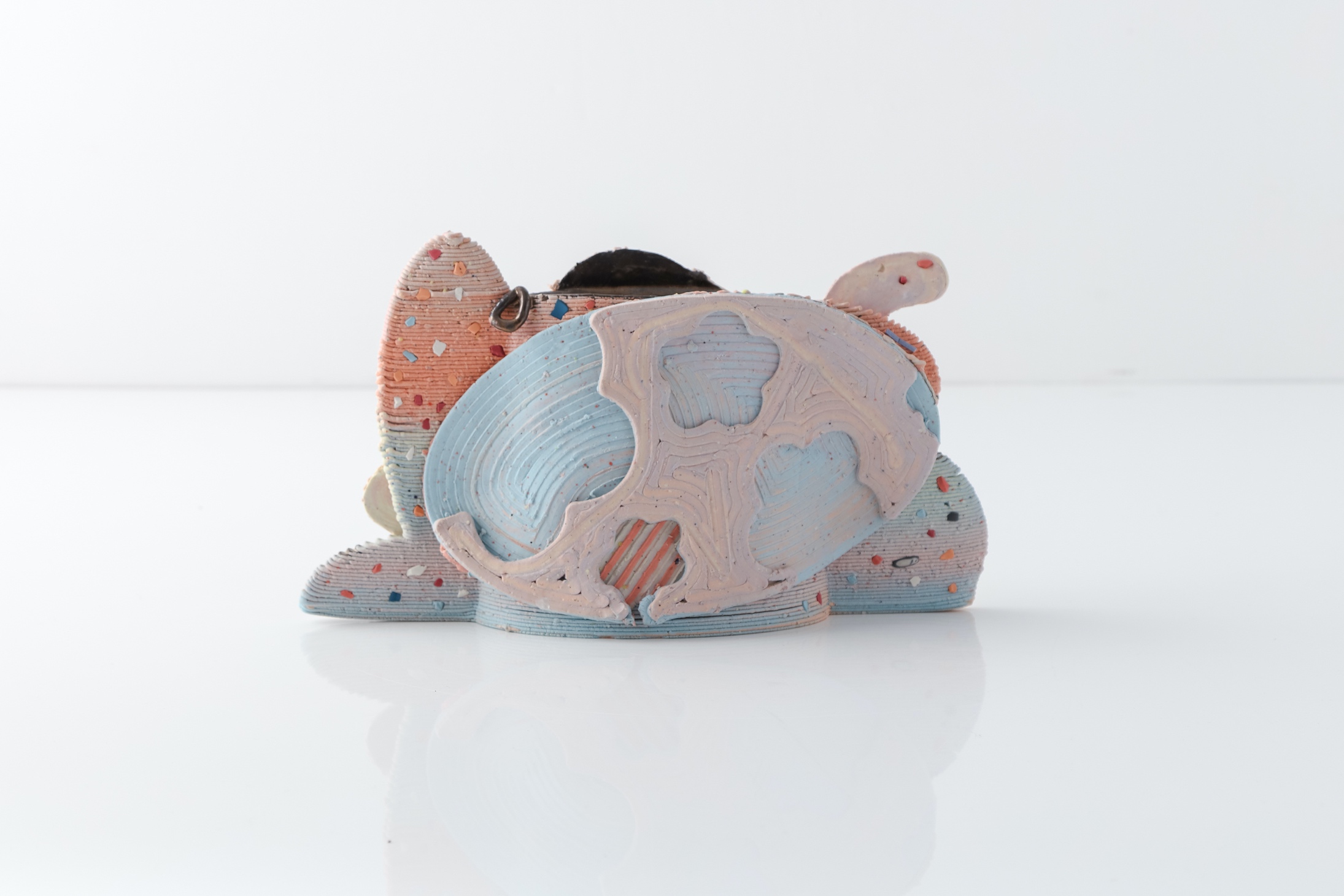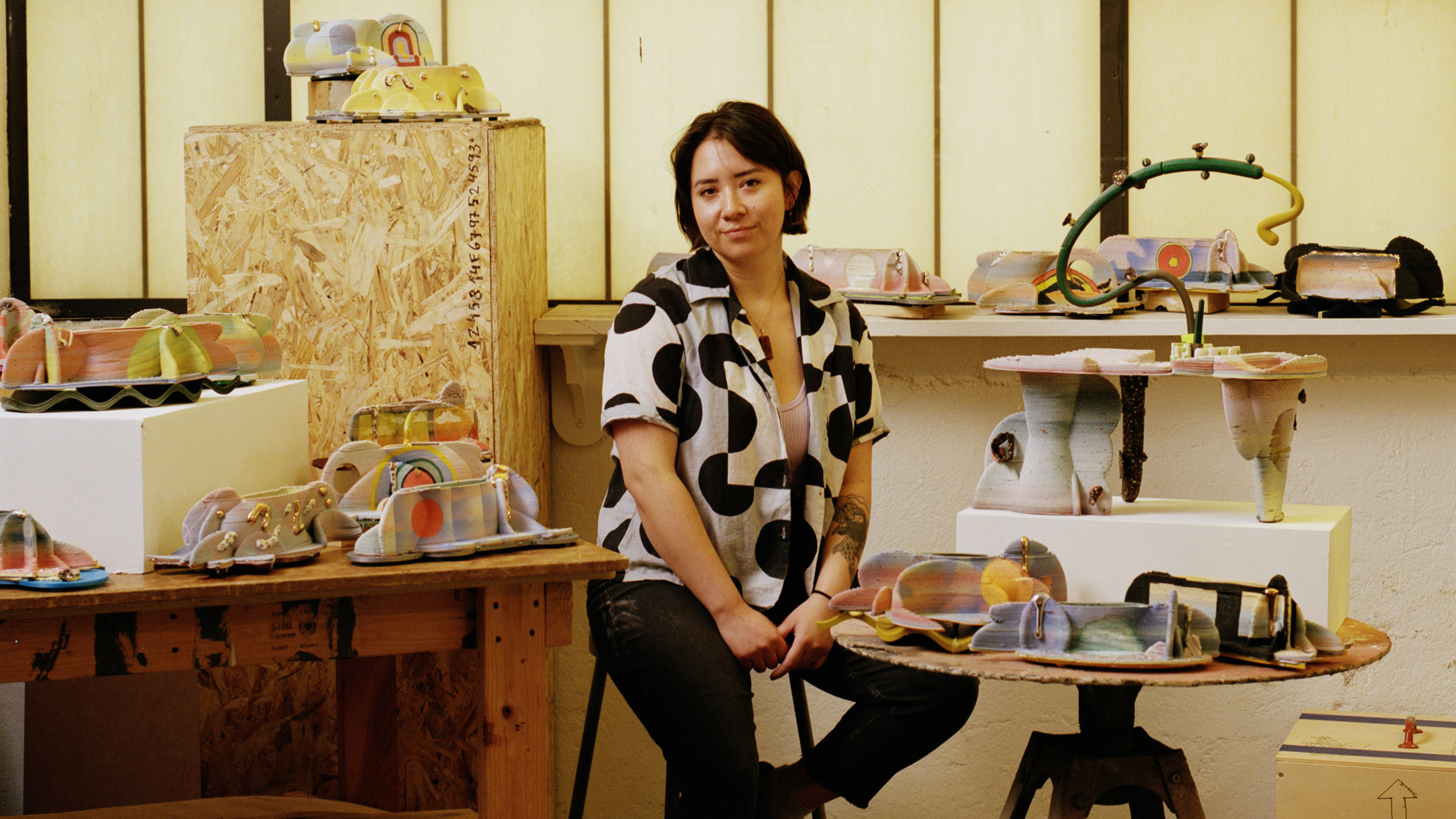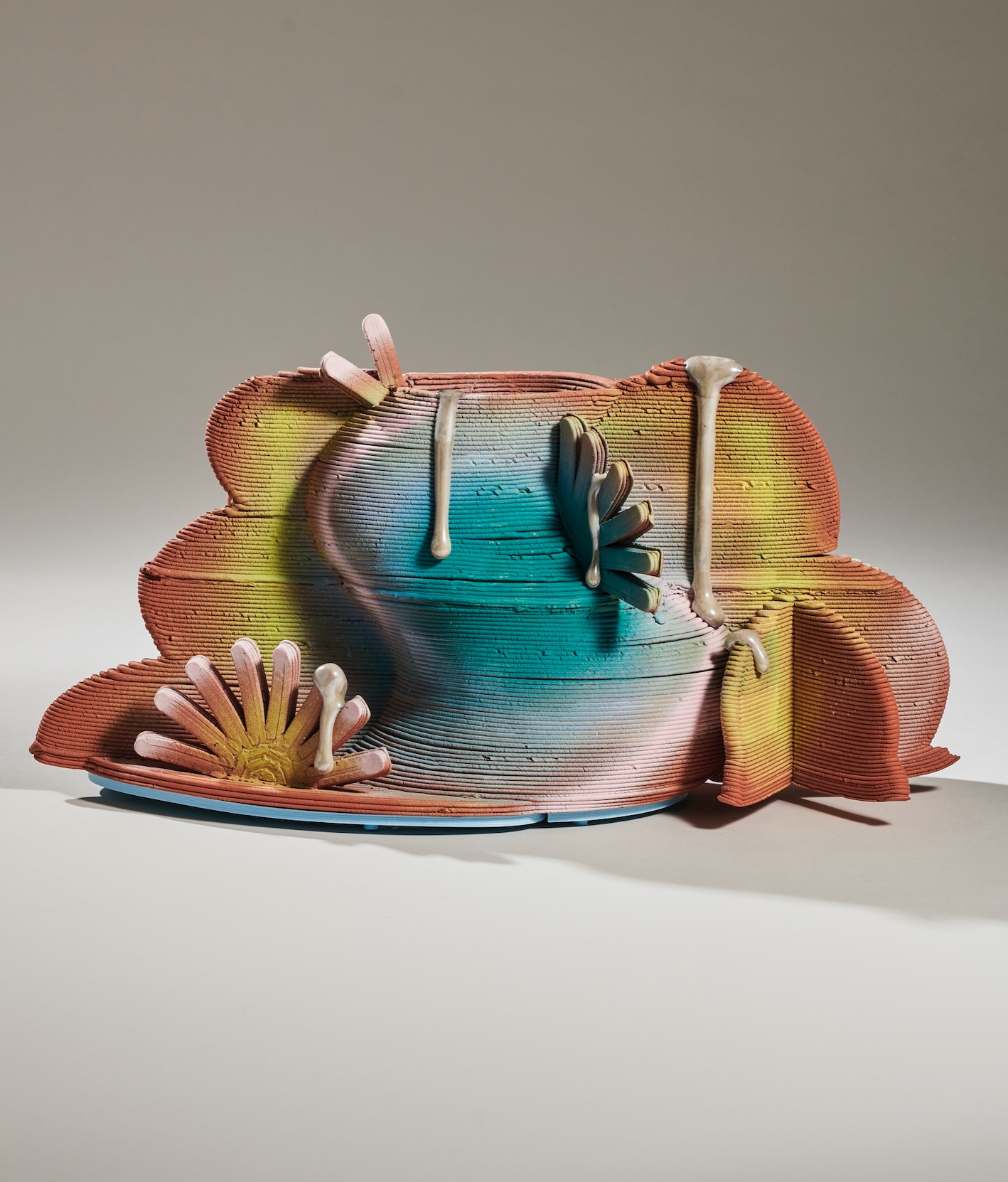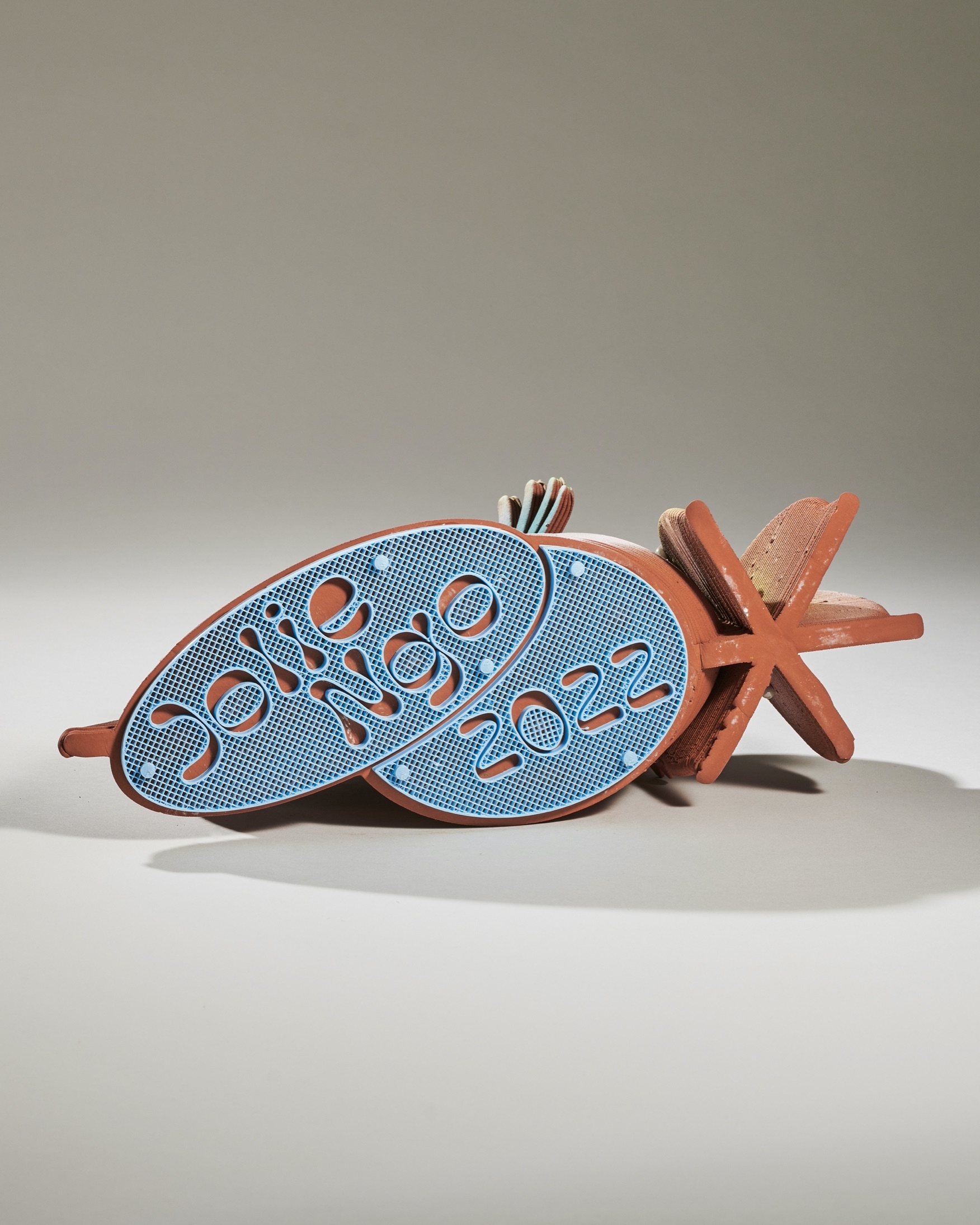The Philadelphia-based designer talks to Vasia Rigou about her process and inspiration, the cyborgian nature of her work and cutting-edge technologies turning into tradition. Did we mention the future generation of robot potters?
 Photography courtesy of Jolie Ngo featuring Sticker Vessel in Baby, unique Sticker vessel in porcelain, glaze, luster, and PVA plastic. Designed and made by Jolie Ngo, USA, 2022
Photography courtesy of Jolie Ngo featuring Sticker Vessel in Baby, unique Sticker vessel in porcelain, glaze, luster, and PVA plastic. Designed and made by Jolie Ngo, USA, 2022
Interview by Vasia Rigou
‘I think I am no longer in the honeymoon phase with clay, things are just steady between us,’ says Jolie Ngo about the material that will always be close to her heart. Ever-evolving, the artist never stands still.
Vasia Rigou: Do you remember a specific moment in time that you realised you fell in love with clay?
Jolie Ngo: It feels hard to say that I am in love with clay, I am not sure that’s true. I think I would consider myself to be more dedicated to clay as a material that will always be within my practice. I think I am no longer in the honeymoon phase with clay, things are just steady between us.
The thing that excites me the most about it as a material is its ability to record the memory of a person or object’s touch. I love the idea that whatever ceramic object that I produce will outlive me for centuries. So, after I pass, there will still be evidence of my touch and presence forever on the work I left behind.
VR: How did you decide to try out 3D printing – a medium that has been frowned upon, especially during its early days?
JN: I had been extremely hesitant to try out clay 3D printing. It took me a long time to warm up to the idea of even 3D printing plastic prototypes to make moulds of, but I do think that was kind of my ‘gateway’ into printing clay.
I think the reason it has become such an integral part of my practice is because I started during my last semester of undergrad at the Rhode Island School of Design (RISD) which happened to coincide with the start of the pandemic.
My professor graciously offered to continue printing and firing work for us – it soon became the only way I was able to continue making work during lockdown. I would say I definitely approached the tool with caution.
 Photography by Guarionex Rodriguez featuring Jolie Ngo
Photography by Guarionex Rodriguez featuring Jolie Ngo
VR: ‘I want to show the ceramic vessel as a future-form that can still hold memories of the past,’ you have said. Where do the lines between cutting- edge technologies and craft traditions almost as old as the human race blur?
JN: At some point ‘cutting-edge technologies’ turn into tradition. I always wonder how the pottery wheel was received when it was first invented. Was there as much disdain or backlash as 3D clay printers originally received when they first came into fruition?
To be specific to my practice, something that blurs the line between the two is keeping the integrity of both mine and my printer’s touch. Tactility and evidence of the hand in the making process are essential to craft traditions, which is why there is some hesitancy around 3D printing clay.
My printer’s touch refers to the overflowing coils, mark-making and ripped and torn clay left behind during the printing process. I think there is this idea that machines only can make hyperperfect objects devoid of the nuance of tactility and sensitivity in other hand crafts.
All of these touches are unexpected, and something about them feels weirdly human and honest. There is a rhythm in the dialogue between me and my printer, our touches are intertwined and together we create objects that resist definition.
 Photography courtesy of Jolie Ngo featuring XL Memory Palace Vessel in Taos, a unique vessel in terracotta. Made and designed by Jolie Ngo, USA
Photography courtesy of Jolie Ngo featuring XL Memory Palace Vessel in Taos, a unique vessel in terracotta. Made and designed by Jolie Ngo, USA
VR: Your work exists between the real and the fantastical. Can you talk about its ‘cyborgian’ nature?
JN: I wouldn’t say my work is cyborgian in terms of shape or colour, but more of the concept/process of creating the work. A cyborg is a being with both organic and biomechatronic body parts; the process of creating my work fits into that description.
Clay is an organic material that is given form by the means of a robot syringe on wheels. That feels like the most obvious cyborgian thing about my practice, but I think I could also say that it is cyborgian in that my touch and my printer’s touch are intertwined in the work. So, something both organic and electronic are coming together to create an object.
VR: Can you walk us through your process?
JN: My process begins on the computer. I don’t really sketch or draw anything beforehand, it’s just easier for me to render ideas of form in Rhino, my modelling software of choice.All of my forms start off with just a basic ellipse and evolve from there. Once I have completed the form, I’ll take it into a slicing software that basically turns my model into a code that my printer is able to read.
I set up my printer by loading the tube with clay and manually homing the z-axis, I upload the .gcode file and start printing. Depending on what I am making, I might just be printing the piece in one go or printing multiple pieces to stack onto each other. After I fire each piece the first time, I will glaze the work. I have really been into airbrushing lately, but sometimes I will hand paint the work as well.
VR: Where do you draw inspiration from?
JN: For the form, I draw inspiration from some of my earliest digital experiences – specifically landscapes from video game worlds. I also look at playground design a lot. I really am into Isamu Noguchi’s playscape design and look at it often.
In terms of surface design, I have been looking at a lot of dazzle camouflage, Iris van Herpen’s clothing design, early computer graphics, anomalous motion illusions, aliasing and Miyoko Ito’s paintings.
 Photography courtesy of Jolie Ngo
Photography courtesy of Jolie Ngo
VR: What are you currently working on? Anything in the works?
JN: I am currently on a little residency tour across the country, so I am not in my home studio at the moment. For the next month, I am a visiting artist-in-residence at the University of Arkansas.
I am taking advantage of all of the tools and facilities the school has to offer, so I am mostly focusing on making tools and moulds I can take with me when I go home. I am mostly continuing my newest body of work I started at the beginning of this year that I call ‘Flatpack Vessels’.
VR: What kind of impact do you hope to make in the world?
JN: I hope I can continue to de-escalate the relationship between the digital and the hand, so that other ceramic artists are more open to the idea of integrating these tools into their practice as well.
I also hope that I am able to play some part in making these tools and information more accessible to everyone, but more specifically to other queer BIPOC artists.
I am one of the very few BIPOC artists in ceramics working with a clay 3D printer as my main way of making, and I know that BIPOC voices are missing in a lot of fields, but they are seriously lacking in the digital fabrication realm of ceramics. I hope I get the honour of being able to help usher in the future generation of robot potters.
Get a curated collection of design and architecture news in your inbox by signing up to our ICON Weekly newsletter


















